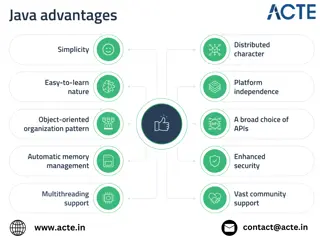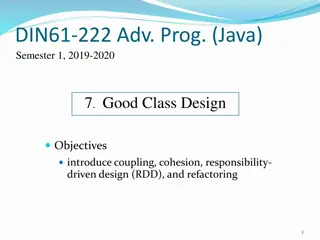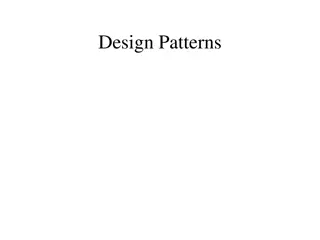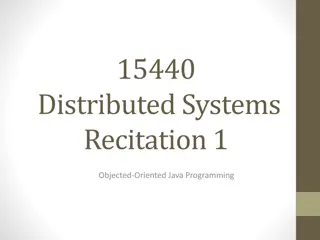Understanding Design Patterns in Java Programming
Learn about design patterns in Java programming, including creational patterns such as Singleton, Factory, and Builder. Explore how design patterns provide solutions to common programming problems, making code more flexible and efficient. Dive into examples and implementations to enhance your understanding of applying design patterns in Java projects.
Download Presentation

Please find below an Image/Link to download the presentation.
The content on the website is provided AS IS for your information and personal use only. It may not be sold, licensed, or shared on other websites without obtaining consent from the author. Download presentation by click this link. If you encounter any issues during the download, it is possible that the publisher has removed the file from their server.
E N D
Presentation Transcript
Section 9: Design Patterns Slides adapted from Alex Mariakakis, with material from David Mailhot, Hal Perkins, Mike Ernst
Agenda What are design patterns? Creational patterns review Structural patterns preview
What Is A Design Pattern A standard solution to a common programming problem A technique for making code more flexible Shorthand for describing program design and how program components are connected
Creational Patterns Problem: Constructors in Java are not flexible Always return a fresh new object, never reuse one Can t return a subtype of the class they belong to Solution: Creational patterns! Sharing Singleton Interning Flyweight Factories Factory method Factory object Builder (new!)
Creational Patterns: Sharing The old way: Java constructors always return a new object Singleton: only one object exists at runtime Factory method returns the same object every time Interning: only one object with a particular (abstract) value exists at runtime Factory method returns an existing object, not a new one Flyweight: separate intrinsic and extrinsic state, represents them separately, and interns the intrinsic state Implicit representation uses no space Not as common/important
Creational Patterns: Singleton For a class where only one object of that class can ever exist Two possible implementations Eager instantiation: creates the instance when the class is loaded to guarantee availability Lazy instantiation: only creates the instance once it s needed to avoid unnecessary creation
Creational Patterns: Singleton Eager instantiation public class Bank { private static Bank INSTANCE = new Bank(); } // private constructor private Bank() { } // factory method public static Bank getInstance() { return INSTANCE; } Bank b = new Bank(); Bank b = Bank.getInstance();
Creational Patterns: Singleton Lazy instantiation public class Bank { private static Bank INSTANCE; } // private constructor private Bank() { } // factory method public static Bank getInstance() { if (INSTANCE == null) { INSTANCE = new Bank(); } return INSTANCE; } Bank b = new Bank(); Bank b = Bank.getInstance();
Creational Patterns: Singleton Would you prefer eager or lazy instantiation for an HTTPRequest class? handles authentication definitely needed for any HTTP transaction Would you prefer eager or lazy instantiation for a Comparator class? compares objects may or may not be used at runtime
Creational Patterns: Interning Similar to Singleton, except instead of just having one object per class, there s one object per abstract value of the class Saves memory by compacting multiple copies Requires the class being interned to be immutable. Why?
Creational Patterns: Interning public class Point { private int x, y; public Point(int x, int y) { this.x = x; this.y = y; } public int getX() { return x; } public int getY() { return y; } } @Override public String toString() { return ( + x + , + y + ) ; }
Creational Patterns: Interning public class Point { private static Map<String, Point> instances = new WeakHashMap<String, Point>(); public static Point getInstance(int x, int y) { String key = x + , , + y; if (!instances.containsKey(key)) instances.put(key, new Point(x,y)); return instances.get(key); } } private final int x, y; // immutable private Point(int x, int y) { } If our point was represented with r and theta, we d need to constrain them for use in the key. Otherwise, we d have 5, pi and 5, 3pi as different entries in our map even though they are the same abstract value.
Creational Patterns: Factories public class City { public Stereotype getStereotypicalPerson() { } } City seattle = new City(); seattle.getSterotypicalPerson(); // we want a SeattleStereotype
Creational Patterns: Factories Factories solve the problem that Java constructors cannot return a subtype of the class they belong to Two options: Factory method Helper method creates and returns objects Method defines the interface for creating an object, but defers instantiation to subclasses Factory object Abstract superclass defines what can be customized Concrete subclass does the customization, returns appropriate subclass Object provides the interface for creating families of related/dependent objects without specifying their concrete classes
Creational Patterns: Factory Method public class City { public Stereotype getStereotypicalPerson() { } } public class Seattle extends City { @Override public Stereotype getStereotypicalPerson() { return new SeattleStereotype(); } } City seattle = new Seattle(); seattle.getSterotypicalPerson();
Creational Patterns: Factory Object interface StereotypeFactory { Stereotype getStereotype(); } class SeattleStereotypeFactory implements StereotypeFactory { public Stereotype getStereotype() { return new SeattleStereotype(); } } public class City { public City(StereotypeFactory f) { } public Stereotype getStereotypicalPerson() { f.getStereotype(); } } City seattle = new City(new SeattleStereotypeFactory()); seattle.getSterotypicalPerson();
Creational Patterns: Builder The class has an inner class Builder and is created using the Builder instead of the constructor The Builder takes optional parameters via setter methods (e.g., setX(), setY(), etc.) When the client is done supplying parameters, she calls build() on the Builder, finalizing the builder and returning an instance of the object desired
Creational Patterns: Builder public class NutritionFacts { // required private final int servingSize, servings; // optional private final int calories, fat, sodium; public NutritionFacts(int servingSize, int servings) { this(servingSize, servings, 0); } public NutritionFacts(int servingSize, int servings, int calories) { this(servingSize, servings, calories, 0); } public NutritionFacts(int servingSize, int servings, int calories, int fat) { this(servingSize, servings, calories, fat, 0); } public NutritionFacts(int servingSize, int servings, int calories, int fat, int sodium) { this.servingSize = servingSize; this.servings = servings; this.calories = calories; this.fat = fat; this.sodium = sodium; } }
Creational Patterns: Builder public class NutritionFacts { private final int servingSize, servings, calories, fat, sodium; public static class Builder { // required private final int servingSize, servings; // optional, initialized to default values private final int calories = 0; private final int fat = 0; private final int sodium = 0; public Builder(int servingSize, int servings) { this.servingSize = servingSize; this.servings = servings; } public Builder calories(int val) { calories = val; return this; } public Builder fat(int val) { fat = val; return this; } public Builder sodium(int val) { sodium = val; return this; } public NutritionFacts build() { return new NutritionFacts(this); } } public NutritionFacts(Builder builder) { this.servingSize = builder.servingSize; this.servings = builder.servings; this.calories = builder.calories; this.fat = builder.fat; this.sodium = builder.sodium; } }
Creational Patterns: Builder Useful when you have many constructor parameters It is hard to remember which order they should all go in Easily allows for optional parameters If you have n optional parameters, you need 2^n constructors, but only one builder
Structural Patterns Problem: Sometimes difficult to realize relationships between entities Important for code readability Solution: Structural patterns! We re just going to talk about wrappers, which translate between incompatible interfaces Pattern Functionality Interface Purpose Adapter same different modify the interface Decorator different same extend behavior Proxy same same restrict access
Structural Patterns: Adapter Changes an interface without changing functionality Rename a method Convert units Why? We already have a class that does most/all what we want It just doesn t do it in the form we want
Structural Patterns: Adapter MSR has a library and API for image composition public void photoComposite(List<Image> photoStack, List<Weight> objectives, Image output); MS PhotoGallery wants to use this API to make new features PhotoGalleryDisplay object contains a DisplayImage that is a 2d array of pixels representing the main image in view Both codebases are very large and changes will affect a lot of other pieces
Structural Patterns: Adapter public class PhotoSynthAdapter { public DisplayImage makePanoramic(List<Image> photos) { Image output = new Image(); List<Weight> objectives = generatePanoWeights(); photoComposite(photos, objectives, output); return ImageToDisplayImage(output); } public DisplayImage removeTourists( )
Structural Patterns: Adapter Other examples: Angles passed in using radians vs. degrees Bytes vs. strings Hex vs. decimal numbers
Structural Patterns: Decorator Adds functionality without changing the interface Add caching Adds to existing methods to do something additional while still preserving the previous spec Add logging Decorators can remove functionality without changing the interface UnmodifiableList with add() and put()
public abstract class Cake{ public abstract double getWeight(); public abstract String getDescription(); } public class PlainCake extends Cake{ public double getWeight() { return 8.0; } } public String getDescription() { return sponge cake ; } from http://en.wikipedia.org/wiki/Decorator_pattern
public abstract class CakeDecorator extends Cake { protected final Cake decoratedCake; protected String separator = ", "; public CakeDecorator (Cake decoratedCake) { this.decoratedCake = decoratedCake; } public double getWeight() { return decoratedCake.getWeight(); } public String getDescription() { return decoratedCake.getDescription(); } } from http://en.wikipedia.org/wiki/Decorator_pattern
class Frosting extends CakeDecorator { public Frosting (Cake decoratedCake) { public double getWeight() { return super.getWeight() + 4.0; } public String getDescription() { return super.getDescription + separator + vanilla frosting ; } } } from http://en.wikipedia.org/wiki/Decorator_pattern
public static void main(String[] args) { Cake c = new PlainCake(); System.out.println( Weight: " + c.getWeight() + "; Contains: " + c.getDescription()); Weight: 8.0 Contains: sponge cake c = new Frosting(c); System.out.println( Weight: " + c.getWeight() + "; Contains: " + c.getDescription()); c = new Roses(c); } buttercream roses Weight: 12.0 Contains: sponge cake, vanilla frosting Weight: 15.5 Contains: sponge cake, vanilla frosting, from http://en.wikipedia.org/wiki/Decorator_pattern
Structural Patterns: Proxy Wraps the class while maintaining the same interface and same functionality Integer vs. int, Boolean vs. boolean Controls access to other objects Communication: manage network details when using a remote object Security: permit access only if proper credentials Creation: object might not yet exist because creation is expensive























